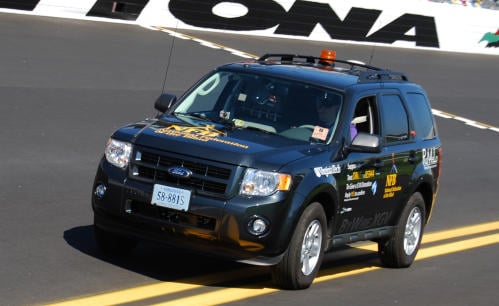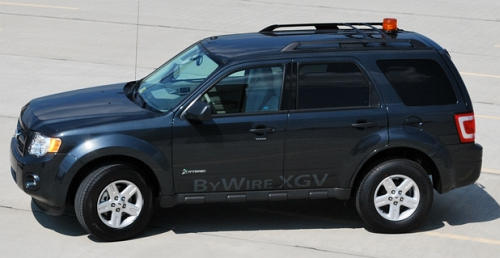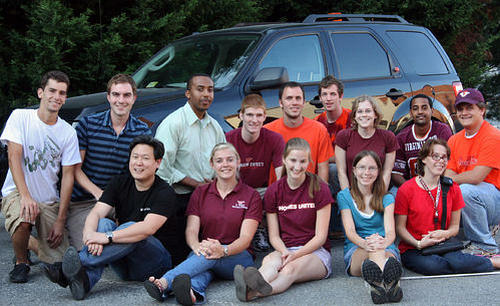In the US, a blind individual has driven a street vehicle for the first time in public without the assistance of a sighted person. Over the weekend, Mark Riccobono successfully navigated 2.4 km of the road course section of the Daytona International Speedway in a Ford Escape hybrid equipped with nonvisual technology.
Riccobono, a blind executive who directs technology, research, and education programs for the National Federation of the Blind, not only successfully navigated the several turns of the road course, but also avoided obstacles, some stationary and some thrown into his path at random from a van driving in front of him. He also successfully passed the van.
The Ford Escape was equipped with laser range-finding sensors that conveyed information to a computer inside the vehicle, allowing it to create and constantly update a three-dimensional map of the road environment. The computer sent directions to vibrating gloves on the driver’s hands, indicating which way to steer, and to a vibrating strip on which he was seated, indicating when to speed up, slow down, or stop.
The demonstration is the current culmination of the NFB’s Blind Driver Challenge project, which set out to challenge universities, technology developers, and other interested innovators to establish BDC teams to build nonvisual interface technologies to empower blind people to drive a car independently.
The NFB Blind Driver Challenge was taken on by Dennis Hong and a team from Virginia Tech’s Robotics and Mechanisms Laboratory (RoMeLa), which successfully demonstrated a prototype blind-drivable dune buggy in May 2009. In June 2010, RoMeLa partnered with Torc Technologies, a leading provider of modular unmanned vehicle technologies, to take the NFB Blind Driver Challenge development further.
New and improved versions of RoMeLa’s nonvisual interfaces were integrated into a ByWire XGV – Torc’s modified Ford Escape Hybrid equipped with ByWire drive-by-wire conversion modules, SafeStop wireless emergency stop system and PowerHub power distribution modules, which was the vehicle driven by Riccobono.
Among the novel interfaces RoMeLa is developing are DriveGrip (a pair of vibrating gloves that relay steering information), SpeedStrip (a vibration-based device that relays speed information) and AirPix, a device that uses compressed airflow patterns to create tactile images.
The goal, of course, is not to develop an autonomous vehicle to drive the blind, but rather a vehicle that enables a blind person to drive. The sensing and perception data normally used to autonomously carry out appropriate driving behaviors are passed to the blind driver through several nonvisual interfaces, who can then reason about the environment, make control decisions, and directly execute these decisions from behind the wheel.
So, perhaps, one day in the not too distant future, the visually-impaired will be able to take to the roads and enjoy the freedom we who are sighted take for granted.
Looking to sell your car? Sell it with Carro.





hope just for the technology sake, even the normal sighted are risky on the road. Good if apply to enhance the vehicle safety for able driver, but i think it must cheaper if a blind just employ a driver.
As someone with low vision, I am amazed with this technology. I am 32, have never driven, and am just now working towards getting a license. I was always told I could not drive, but I recently got reviewed by the Wilmer’s Eye Institute and the MTA that said otherwise. I am very nervous and wish I had this technology to comfort me. I can tell you that mobility is worthless and taxies are ridiculously expensive, especially if you live outside the MTA service area. Getting to and from work, going to interviews and meetings, and just living is timeless instead of timely when you don’t drive and can become extremely costly on a daily basis. I had job issues and missed important appointments because mobility did not picking me up on time Furthermore, a bus ride is more than triple the time it takes to drive anywhere. I hope the legally blind can take to the roads someday and be independent instead of relying on an unreliable support system or troubling family members for transportation support. This technology is definitely a important step in providing the blind with the same benefits that everyone else takes for granted.
Damn. Now I no longer can scream at those bad drivers going “OI, BUTA KA LU?”